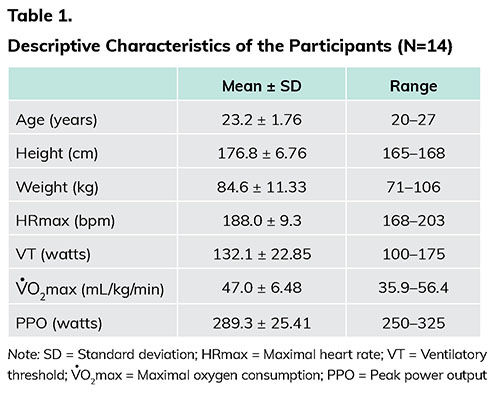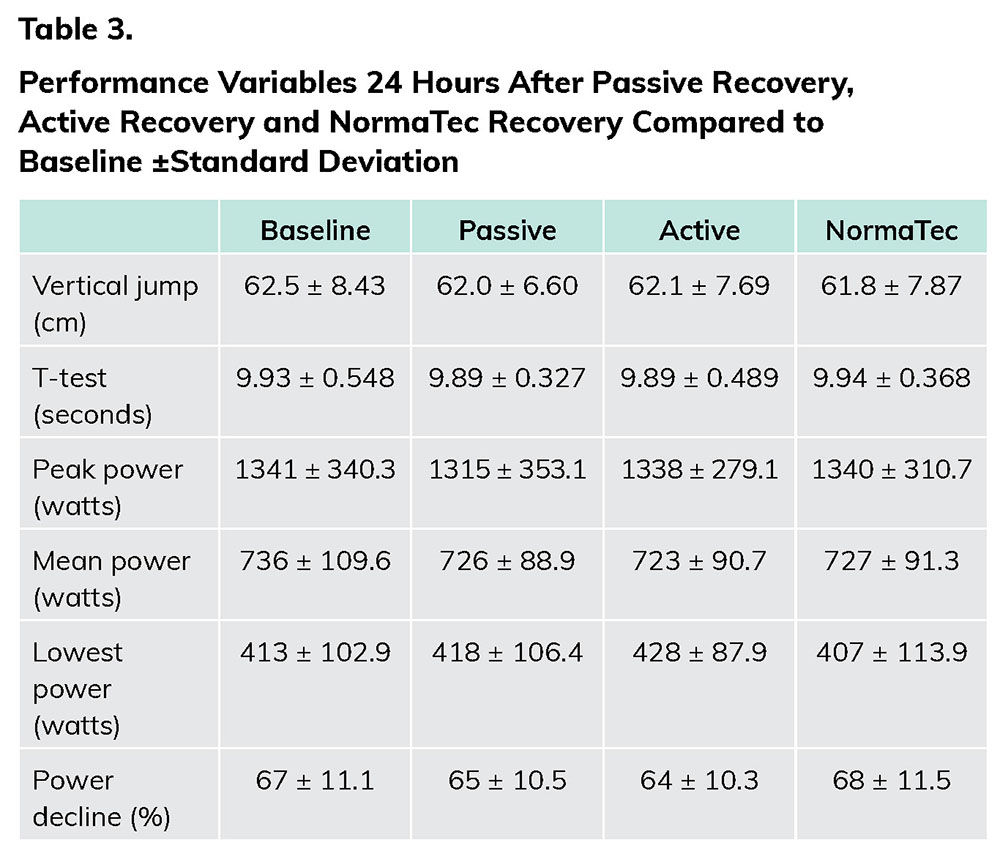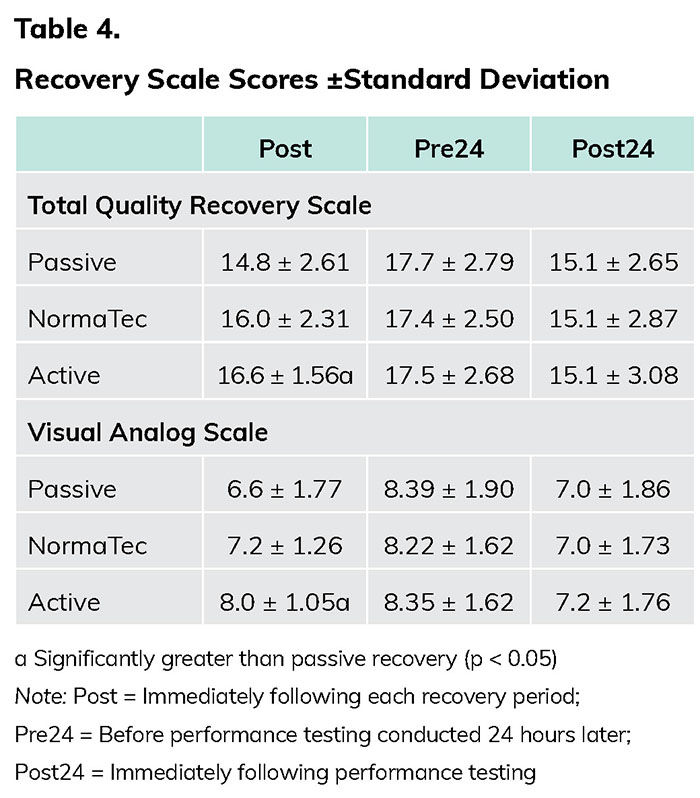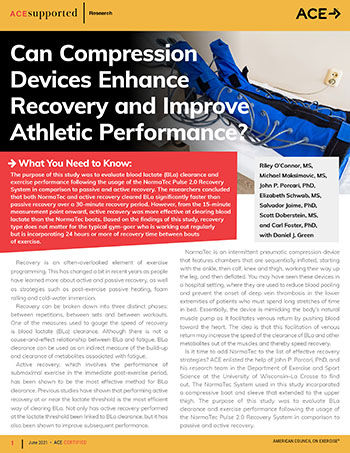
By Riley O’Connor, MS, Michael Maksimovic, MS, John P. Porcari, PhD, Elizabeth Schwab, MS, Salvador Jaime, PhD, Scott Doberstein, MS, and Carl Foster, PhD, with Daniel J. Green
What You Need to Know
The purpose of this study was to evaluate blood lactate (BLa) clearance and exercise performance following the usage of the NormaTec Pulse 2.0 Recovery System in comparison to passive and active recovery. The researchers concluded that both NormaTec and active recovery cleared BLa significantly faster than passive recovery over a 30-minute recovery period. However, from the 15-minute measurement point onward, active recovery was more effective at clearing blood lactate than the NormaTec boots. Based on the findings of this study, recovery type does not matter for the typical gym-goer who is working out regularly but is incorporating 24 hours or more of recovery time between bouts of exercise.
Recovery is an often-overlooked element of exercise programming. This has changed a bit in recent years as people have learned more about active and passive recovery, as well as strategies such as post-exercise passive heating, foam rolling and cold-water immersion.
Recovery can be broken down into three distinct phases: between repetitions, between sets and between workouts. One of the measures used to gauge the speed of recovery is blood lactate (BLa) clearance. Although there is not a cause-and-effect relationship between BLa and fatigue, BLa clearance can be used as an indirect measure of the build-up and clearance of metabolites associated with fatigue.
Active recovery, which involves the performance of submaximal exercise in the immediate post-exercise period, has been shown to be the most effective method for BLa clearance. Previous studies have shown that performing active recovery at or near the lactate threshold is the most efficient way of clearing BLa. Not only has active recovery performed at the lactate threshold been linked to BLa clearance, but it has also been shown to improve subsequent performance.
NormaTec is an intermittent pneumatic compression device that features chambers that sequentially inflated, starting with the ankle, then calf, knee and thigh, working their way up the leg, and then deflated. You may have seen these devices in a hospital setting, where they are used to reduce blood pooling and prevent the onset of deep vein thrombosis in the lower extremities of patients who must spend long stretches of time in bed. Essentially, the device is mimicking the body’s natural muscle pump as it facilitates venous return by pushing blood toward the heart. The idea is that this facilitation of venous return may increase the speed of the clearance of BLa and other metabolites out of the muscles and thereby speed recovery.
Is it time to add NormaTec to the list of effective recovery strategies? ACE enlisted the help of John P. Porcari, PhD, and his research team in the Department of Exercise and Sport Science at the University of Wisconsin–La Crosse to find out. The NormaTec System used in this study incorporated a compressive boot and sleeve that extended to the upper thigh. The purpose of this study was to evaluate BLa clearance and exercise performance following the usage of the NormaTec Pulse 2.0 Recovery System in comparison to passive and active recovery.
The Study
The research team recruited 15 apparently healthy male college students between the ages of 20 and 27 years old. They were all exercising at least five times per week, including high-intensity training at least once per week, and did not have any lower-extremity or back injuries during the prior six months.
Each participant first completed a maximal cycle ergometer test to determine maximal oxygen consumption (VO2max), maximal heart rate (HRmax), ventilatory threshold (VT) and peak power output (PPO) (Table 1). One participant dropped out of the study due to an orthopedic injury unrelated to the study protocol.

At least 24 hours later, the participants performed baseline testing for vertical jump height, agility (using a T-test) and anaerobic power (using the Wingate test on a cycle ergometer).
At least 48 hours after the baseline testing, the participants returned to perform a high-intensity Tabata-style training session on a cycle ergometer. After warming up for five minutes at a self-selected pace, each participant completed a Tabata-style workout, which consisted of 20 seconds of work at a power output equal to 125% of the individual’s PPO, paired with 10 seconds of unloaded pedaling, for a total of eight sets lasting four minutes. They then cooled down for three minutes at a self-selected pace.
After the workout, the participants were randomly selected to recover for 30 minutes in one of three ways:
- Passive recovery: Sitting in a reclined position with the feet elevated
- Active recovery: Cycling at a power output 10% below the participant’s VT
- NormaTec recovery: Sitting in a reclined position with the feet elevated while wearing the NormaTec Pulse 2.0 Recovery System at the maximal setting
BLa was measured before exercise, immediately after the cool-down and then in five-minute increments during the 30 minutes of recovery.
In addition, each participant filled out two subjective recovery questionnaires after the recovery period. On the Visual Analog Scale, they placed a mark on a 10-cm line to indicate how they felt on a scale of 0 (not recovered at all) to 10 (fully recovered). On the Total Quality Recovery Scale, they quantified their recovery on a scale of 6 (very, very poor recovery) to 20 (very, very good recovery).
Finally, the participants returned 24 hours later to fill out the recovery questionnaires; perform the tests for vertical jump height, agility and anaerobic power; and then complete the questionnaires once again.
The entire test sequence was repeated three times so that each participant completed the process with each of the three recovery strategies, with a minimum of 72 hours between the Tabata-style workouts and recovery sessions.
The Results
BLa values at each time point for each of the three recovery modalities are presented in Table 2 and Figure 2. BLa clearance for both the NormaTec and active recovery conditions was significantly faster than passive recovery at the 5-, 10-, 20-, 25-, and 30-minute measurement periods. Active recovery cleared BLa significantly faster than NormaTec at the 15-, 20-, 25-, and 30-minute measurement periods. There was no significant difference between active recovery and NormaTec at the 5- and 10-minute time points.


Figure 2. Blood lactate clearance among the Passive, NormaTec and Active recovery conditions
Note: Pre = Prior to the workout; Post = Immediately after cool-down; 5, 10, 15, 20, 25 and 30 = Minutes after cool-down
The performance results following each recovery condition are presented in Table 3. There was no significant difference in vertical jump height, T-Test time, or any of the Wingate performance variables among the recovery conditions or when compared to baseline.

Data for the two recovery scale questionnaires among the three different recovery modalities are presented in Table 4. On both questionnaires, subjects felt significantly more recovered immediately following the active recovery compared to the passive recovery condition.

The Bottom Line
The purpose of this study was to evaluate BLa clearance and assess exercise performance after using the NormaTec Pulse 2.0 Recovery System compared to passive and active recovery. The researchers concluded that both NormaTec and active recovery cleared BLa significantly faster than passive recovery over a 30-minute recovery period. During the first 10 minutes of recovery, there was no difference in BLa clearance between the NormaTec boots and active recovery. However, from the 15-minute measurement point onward, active recovery was more effective at clearing blood lactate than the NormaTec boots.
The three exercise performance tests were chosen to reflect physical attributes that would affect athletic performance, namely agility (T-test) and anaerobic power (Wingate test and vertical jump). The researchers found no difference in peak power, mean power or power decline following any of the recovery techniques.
According to Dr. Porcari, this may be the result of the 24-hour period between the Tabata-style protocol/recovery session and the completion of the performance tests. As he explains, it’s likely that the participants were “physiologically back to normal” after 24 hours. In contrast, he says, NormaTec may be more beneficial for athletes who perform multiple bouts or heats of exercise in a single day—swimmers, track athletes and the like—who would benefit from the more rapid removal of BLa and other waste products.
Perhaps the biggest benefit, according to anecdotal statements by the study participants, is how good NormaTec feels. The massage-like experience provided relaxation and a potential stress-relief or mental-health benefit.
Stated simply, however, according to the findings of this study, recovery type does not matter for the typical gym-goer who is working out regularly but is incorporating 24 hours or more of recovery time between bouts of exercise.





 by
by 








